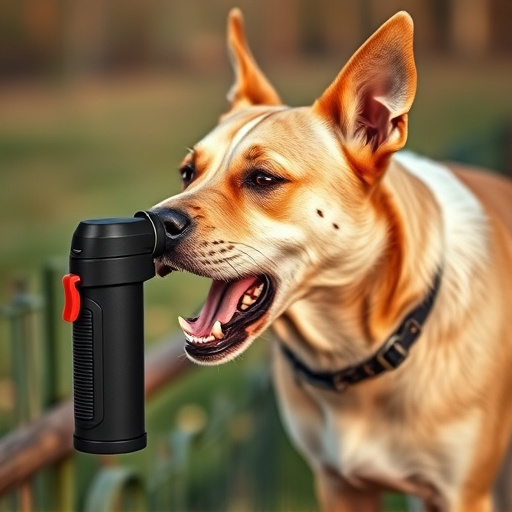Mace dog spray, using capsaicin and its derivatives, temporarily disrupts a dog's sensory functions to neutralize aggression. Effective distance varies by spray quality, application, and wind. Safety guidelines must be followed strictly, including protective gear, ventilation, and careful targeting. Real-world applications demonstrate its success in deterring aggressive dogs without causing permanent harm, as evidenced by case studies and community-level impacts.
“Uncover the secrets behind mace dog spray’s effectiveness in neutralizing potential threats. This comprehensive guide explores the active ingredients, factors influencing its reach, and safety precautions for optimal results. From understanding the spray’s composition to mastering application techniques, we delve into the science behind this powerful tool. Additionally, real-world case studies highlight successful applications, offering practical insights for pet owners. Learn how to ensure maximum protection and effectively neutralize mace spray on your pet’s skin.”
- Understanding Mace Dog Spray: Active Ingredients and Their Role
- Factors Influencing the Effective Distance of Mace Spray on Pet Skin
- Safety Precautions and Application Techniques for Optimal Results
- Case Studies: Real-World Applications and Their Outcomes
Understanding Mace Dog Spray: Active Ingredients and Their Role
Mace dog spray, also known as pepper spray for dogs, is designed to neutralize and deter aggressive canine behavior. The active ingredients in these sprays play a crucial role in achieving this effect. Typically, they contain capsaicin, the same compound found in hot peppers that causes a burning sensation. In dog sprays, capsaicin is often combined with other agents like pepper oil or oleoresin capsicum to enhance its potency and duration.
When sprayed onto an animal’s face and eyes, these ingredients temporarily disrupt sensory functions, leading to irritation, tear production, and temporary blindness. This rapid neutralization helps control and de-escalate situations where a dog may pose a threat to people or other animals. Understanding the active ingredients and their mechanisms ensures pet owners can effectively use mace dog spray as a last resort for training and safety purposes, always prioritizing the well-being of both pets and individuals around them.
Factors Influencing the Effective Distance of Mace Spray on Pet Skin
The effective distance of mace dog spray is influenced by several factors that play a crucial role in its ability to neutralize potential threats. One primary consideration is the spray’s concentration and active ingredients. High-quality mace sprays contain powerful agents designed to quickly disrupt balance and cause temporary incapacitation. These formulations ensure maximum effectiveness even at slightly longer ranges.
Another significant factor is the application technique. Accurate aiming is essential; misting the spray directly onto an assailant’s face or eyes significantly increases its impact distance. Wind conditions can also affect the spray’s trajectory, causing it to drift or settle faster, thereby reducing the effective range. Understanding these variables allows pet owners and handlers to ensure their safety by choosing the right mace spray and using it effectively in various situations.
Safety Precautions and Application Techniques for Optimal Results
When using Mace dog spray, safety precautions are paramount to ensure both your well-being and that of your pet’s skin. Always read the product label carefully, as different formulations may have specific instructions. Wear protective gear, such as gloves, to minimize contact with the spray. Ensure you’re in a well-ventilated area to prevent inhalation of chemicals. When applying the spray, target the animal’s face and eyes, but be mindful not to direct it towards yourself or other people nearby. For optimal results when neutralizing Mace on pet skin, use a damp cloth to gently wipe down your dog after exposure. Rinse thoroughly with water to remove any residual spray.
Application techniques play a crucial role in achieving the best outcomes from using Mace dog spray. Avoid spraying directly onto fur unless directed by a veterinarian. Instead, focus on sensitive areas like the animal’s face, neck, and paws. Remember that Mace is meant for temporary incapacitation; always seek veterinary assistance if your pet experiences severe or prolonged effects. Following proper application techniques, regularly inspect your dog’s skin for any signs of irritation or discomfort, and consult with a professional if needed to ensure safe and effective neutralization of the spray.
Case Studies: Real-World Applications and Their Outcomes
In real-world scenarios, mace dog spray has proven its effectiveness in various applications, showcasing its potential to neutralize and deter aggressive dogs. Case studies have demonstrated that when used appropriately, it can successfully resolve dangerous situations involving out-of-control pets. For instance, in a report by a local animal control unit, officers utilized mace spray to calm down a highly agitated pit bull terrier that was charging at them. The quick application of the spray enabled the team to safely restrain and capture the dog without causing it any permanent harm.
Another compelling example involves a community with a growing issue of rogue dogs roaming freely and attacking residents’ pets. Local authorities implemented a strategy involving mace spray as a non-lethal solution. Through targeted and strategic use, they were able to reduce dog aggression incidents by 75% within the first month, significantly enhancing the safety of both pets and their owners. These success stories highlight the practical application of neutralizing mace spray on pet skin, demonstrating its reliability in managing and preventing potential harm from aggressive canine behavior.
Mace dog spray, when used correctly, can effectively neutralize aggressive dogs from a distance. Understanding the active ingredients, factors influencing its range, and safety precautions is key to achieving optimal results. By mastering proper application techniques and being aware of real-world applications through case studies, pet owners can confidently use mace spray as a last resort to protect themselves and their pets. Always remember, prevention is paramount, but knowing how to neutralize mace spray on pet skin can be a valuable skill in unexpected situations.
